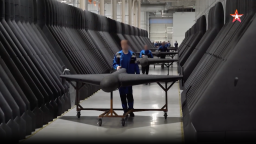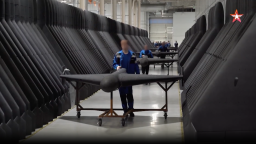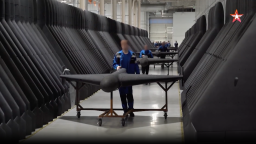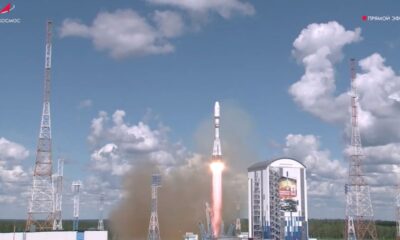Education
Russia Expands Drone Production, Marginalizes Iran’s Role

Russia has significantly expanded its drone production capabilities at the Alabuga facility, integrating the Iranian-designed Shahed-136 drones into its military manufacturing sector. This shift has effectively sidelined Iran in the process, raising concerns about the future of their strategic partnership.
Located approximately 600 miles east of Moscow in Tatarstan, the Alabuga factory has become a key player in producing the Shahed-136, known as Geran in Russia. According to CEO Timur Shagivaleev, the facility has achieved a remarkable level of self-sufficiency, producing the majority of drone components locally. “Aluminium bars come in, engines are made from them; microelectronics are made from electric chips; fuselages are made from carbon fiber and fiberglass,” he states in a recent documentary. This local production has allowed Russia to absorb the drone’s manufacturing into its military industrial complex.
Intelligence assessments indicate that approximately 90% of the production stages for the Shahed-136 now occur within Russia. Recent satellite imagery reveals ongoing expansions at Alabuga, including additional production facilities and dormitories to accommodate a growing workforce. Analysts suggest this growth could enable Russia to export a modernized version of the drone back to Iran, potentially altering the dynamics of their relationship.
Despite initial cooperation between Moscow and Tehran, reports indicate increasing frustration from Iran regarding the perceived lack of support from Russia. According to a Western intelligence source, Tehran has expressed impatience over the inadequate returns it has received for its assistance, which has included providing missiles and other military assets to Russia.
This discontent was particularly evident during Israel’s recent military campaign against Iran’s nuclear program, where Iranian analysts noted that Russia’s response was insufficient given the level of support Iran has provided since Russia’s full-scale invasion of Ukraine began in February 2022. Ali Akbar Dareini, an analyst at the Tehran-based Center for Strategic Studies, commented, “Iran may have expected Russia to do more or take more steps without being required to do so.”
Russia’s approach has been characterized as transactional. The Western intelligence official emphasized that the relationship is driven by immediate interests, stating, “This explicit disengagement demonstrates that Russia never intervenes beyond its immediate interests, even when a partner is attacked.”
Since the commencement of the war in Ukraine, Russia has increasingly relied on Iranian drones. In early 2023, the two nations formalized a $1.75 billion agreement to produce the Shahed drones domestically. By September 2025, Russia is expected to manufacture 6,000 drones, with current production rates exceeding 5,500 units per month. This efficiency has significantly reduced costs; the price per drone has dropped from an average of $200,000 in 2022 to approximately $70,000 by 2025.
Notably, the drones have been upgraded with improved communications, longer-lasting batteries, and larger warheads, making them more effective in combat. While Iran initially welcomed Russia’s efforts to localize production, the rapid advancements may have caught Tehran off guard. A Western intelligence source pointed out that this evolution signifies a gradual loss of control for Iran over the manufactured product.
Amid the expansion of Alabuga, there have been reports of unmet obligations to Iranian partners, including claims of outstanding payments to Iranian companies like Sahara Thunder. These financial issues are compounded by international sanctions on the Russian economy. Although CNN has not independently verified these claims, the situation adds to Tehran’s frustration regarding the technology transfer that was promised in exchange for its support.
In the wake of recent conflicts, Iran has begun to recalibrate its approach, seeking to regroup and rebuild its military capabilities. David Albright, a former UN weapons inspector, suggests that the expansion of Alabuga could facilitate the transfer of upgraded Shahed drones back to Iran, providing critical support as Tehran seeks to replenish its stockpiles.
Open-source flight tracking data has indicated military activity between Russia and Iran, including a flight from Moscow to Tehran by a Gelix Airlines Ilyushin-76 cargo plane, which is often used to transport military materials. Reports suggest that this flight may have delivered components for an S-400 air defense system to Iran.
Despite the current tensions, analysts like Dareini hold the view that both nations will continue to benefit from their partnership. He asserts, “Iran has got, and very likely will get, the things it needs for its own security, whether it’s military hardware, economic cooperation, or technology.”
As the geopolitical landscape evolves, the relationship between Russia and Iran remains complex, characterized by both cooperation and competition. The ongoing developments at Alabuga highlight the potential for further shifts in their alliance as both countries navigate their respective interests in a changing international environment.
-

 Lifestyle3 weeks ago
Lifestyle3 weeks agoBelton Family Reunites After Daughter Survives Hill Country Floods
-

 Technology3 weeks ago
Technology3 weeks agoDiscover the Top 10 Calorie Counting Apps of 2025
-

 Education4 weeks ago
Education4 weeks agoWinter Park School’s Grade Drops to C, Parents Express Concerns
-

 Technology2 weeks ago
Technology2 weeks agoHarmonic Launches AI Chatbot App to Transform Mathematical Reasoning
-

 Technology4 weeks ago
Technology4 weeks agoMeta Initiates $60B AI Data Center Expansion, Starting in Ohio
-

 Technology4 weeks ago
Technology4 weeks agoByteDance Ventures into Mixed Reality with New Headset Development
-

 Lifestyle4 weeks ago
Lifestyle4 weeks agoNew Restaurants Transform Minneapolis Dining Scene with Music and Flavor
-

 Technology3 weeks ago
Technology3 weeks agoMathieu van der Poel Withdraws from Tour de France Due to Pneumonia
-

 Technology3 weeks ago
Technology3 weeks agoRecovering a Suspended TikTok Account: A Step-by-Step Guide
-

 Technology3 weeks ago
Technology3 weeks agoGlobal Market for Air Quality Technologies to Hit $419 Billion by 2033
-

 Health4 weeks ago
Health4 weeks agoSudden Vision Loss: Warning Signs of Stroke and Dietary Solutions
-

 Technology4 weeks ago
Technology4 weeks agoTrump Faces Internal Struggles Over Epstein Files Handling





















